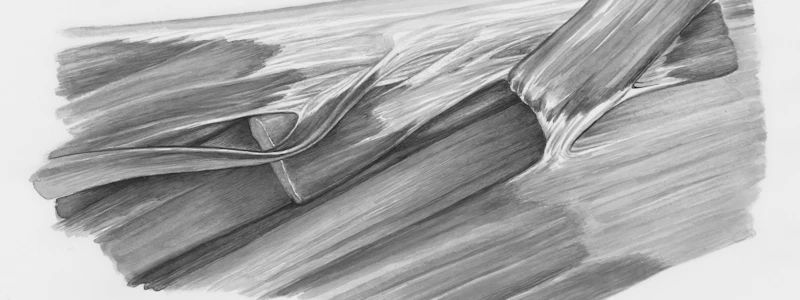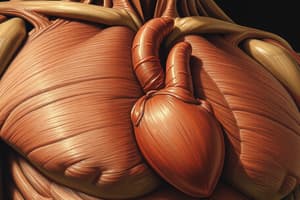Podcast
Questions and Answers
Which type of muscle tissue is characterized by being involuntary and striated?
Which type of muscle tissue is characterized by being involuntary and striated?
- Cardiac Muscle (correct)
- Skeletal Muscle
- Smooth Muscle
- Fibrous Muscle
What is the primary characteristic of smooth muscle in terms of its shape?
What is the primary characteristic of smooth muscle in terms of its shape?
- Square-shaped
- Long and cylindrical
- Branched and cylindrical
- Spindle-shaped (correct)
Which connective tissue layer surrounds an entire muscle and provides support?
Which connective tissue layer surrounds an entire muscle and provides support?
- Endomysium
- Perimysium
- Bursa
- Epimysium (correct)
What kind of control is skeletal muscle under?
What kind of control is skeletal muscle under?
Which component of skeletal muscle surrounds bundles of muscle fibers?
Which component of skeletal muscle surrounds bundles of muscle fibers?
What is the primary function of skeletal muscle in producing body heat?
What is the primary function of skeletal muscle in producing body heat?
Which structure primarily connects muscle to bone?
Which structure primarily connects muscle to bone?
Which type of muscle tissues lack striations?
Which type of muscle tissues lack striations?
Skeletal muscle is described as spindle-shaped with a single nucleus.
Skeletal muscle is described as spindle-shaped with a single nucleus.
Cardiac muscle is both striated and involuntary.
Cardiac muscle is both striated and involuntary.
Smooth muscle cells are characterized by having multiple nuclei.
Smooth muscle cells are characterized by having multiple nuclei.
The epimysium is a thin layer of connective tissue surrounding individual muscle fibers.
The epimysium is a thin layer of connective tissue surrounding individual muscle fibers.
Tendons are fibrous connective tissues that attach muscle to bone.
Tendons are fibrous connective tissues that attach muscle to bone.
The primary function of skeletal muscle includes automatic heat production.
The primary function of skeletal muscle includes automatic heat production.
The perimysium surrounds individual muscle fibers and facilitates nutrient exchange.
The perimysium surrounds individual muscle fibers and facilitates nutrient exchange.
A bursa is a small fluid-filled sac that reduces friction between tissues such as tendons and bones.
A bursa is a small fluid-filled sac that reduces friction between tissues such as tendons and bones.
Flashcards
Skeletal Muscle
Skeletal Muscle
Muscle tissue that is attached to bones and allows for voluntary movement.
Cardiac Muscle
Cardiac Muscle
Muscle tissue found only in the heart, responsible for pumping blood.
Smooth Muscle
Smooth Muscle
Muscle tissue in the walls of internal organs, responsible for involuntary movements like digestion.
Muscle Origin
Muscle Origin
Signup and view all the flashcards
Muscle Insertion
Muscle Insertion
Signup and view all the flashcards
Tendon
Tendon
Signup and view all the flashcards
Muscle Function: Movement
Muscle Function: Movement
Signup and view all the flashcards
Muscle Function: Posture
Muscle Function: Posture
Signup and view all the flashcards
Muscle Striations
Muscle Striations
Signup and view all the flashcards
Aponeurosis
Aponeurosis
Signup and view all the flashcards
Study Notes
Muscle Tissue Types
- Three main types of muscle tissue: skeletal, cardiac, and smooth
- Each type has unique characteristics in shape, striations, nuclei, and function
Muscle Type Differentiation
| Characteristic | Skeletal Muscle | Cardiac Muscle | Smooth Muscle |
|---|---|---|---|
| Overall Shape | Long, cylindrical | Branched, cylindrical | Spindle-shaped |
| Striations | Yes (striated) | Yes (striated) | No (nonstriated) |
| Nuclei | Multinucleated | Usually one or two nuclei | Single nucleus |
| Functional Characteristics | Voluntary (conscious control) | Involuntary (automatic) | Involuntary (automatic) |
| Examples | Muscles attached to bones (e.g., biceps, quadriceps) | Heart muscle (myocardium) | Walls of hollow organs (e.g., intestines, blood vessels) |
Gross Structure of Skeletal Muscle
- Epimysium: Connective tissue surrounding the entire muscle
- Perimysium: Connective tissue surrounding fascicles (bundles of muscle fibers)
- Endomysium: Connective tissue surrounding individual muscle fibers
- Fascicles: Bundles of muscle fibers, functional units
Terms Relating to Muscles
- Origin: Less movable, typically proximal attachment point
- Insertion: More movable, typically distal attachment point
- Tendon: Fibrous connective tissue attaching muscle to bone
- Aponeurosis: Broad, flat tendon attaching muscles
- Bursa: Fluid-filled sac reducing friction between tissues
- Synovial Membrane: Membrane lining joint cavities, producing lubricating fluid
- Tendon Sheath: Protective covering around a tendon, reducing friction
Primary Functions of Skeletal Muscle
- Movement: Facilitates bone and joint movement
- Posture Maintenance: Maintains body posture and stability
- Heat Production: Generates heat through contractions
Muscle Contraction and Bone Movement
- Muscle contraction shortens muscle fibers through the sliding filament mechanism (actin and myosin sliding)
- Contraction pulls on tendons, causing bone movement
- Muscles typically act across a joint, pulling the insertion toward the origin
Studying That Suits You
Use AI to generate personalized quizzes and flashcards to suit your learning preferences.
Description
Explore the three main types of muscle tissue: skeletal, cardiac, and smooth. This quiz covers their unique structures, functions, and characteristics, helping you differentiate between each type effectively.



